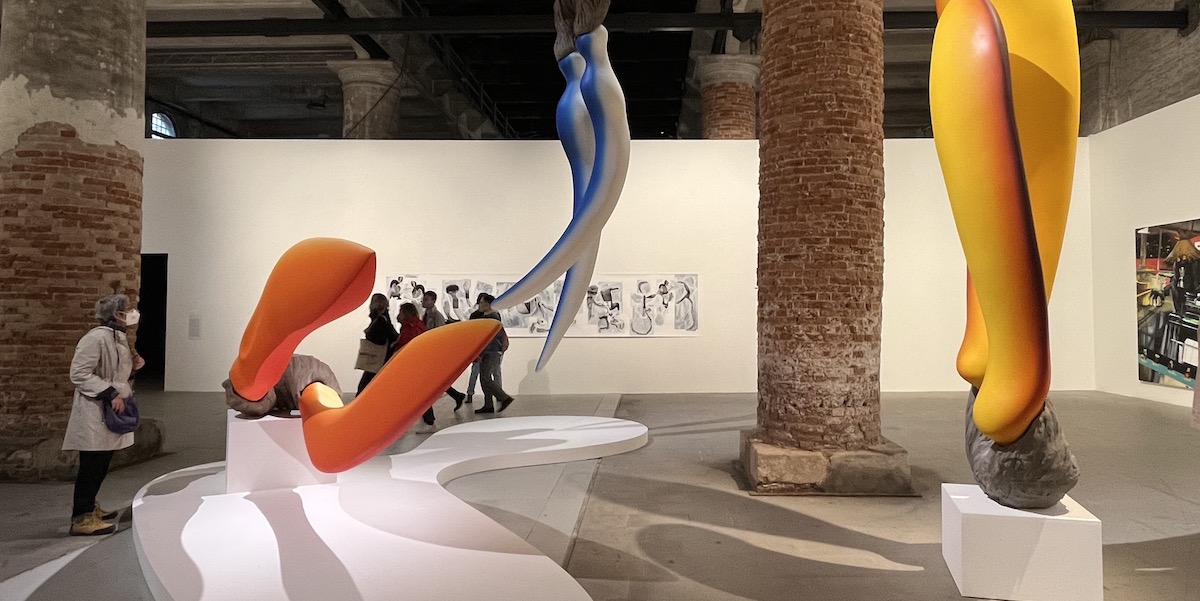Attending the opening of the Venice Biennale was an event I was truly looking forward to. Bored by hours of looking at Art on a screen, not only was I eager to see Art in the flesh again, but I wanted to be reunited with Art friends, collectors and artists, some of whom I had not seen for years. I was curious to see how the Curator Cecilia Alemani – one of the few female curators of the Biennale after Bice Curiger in 2011 and Christine Macel in 2017 – was going to address the pandemic of the last two years and how this historical moment we all went through was going to be reflected in one of the most important non-commercial Art rendez-vous. I was not disappointed: it was a feast for the eyes and a challenge for the mind: the right balance between the emotions that Art should trigger and the intellectual thoughts it should generate.
I was seduced by the exhibition concept and the story-telling.
First of all, I was seduced by the exhibition concept and the story-telling. In her statement, Alemani explained that she did not intend to make a biennale about the pandemic but rather tackle questions that we all asked ourselves during those long months of confinement and uncertainties: the relationships between science, the body and nature, the idea of metamorphosis. Starting with the English-born Mexican artist Leonora Carrington’s children’s book, “the Milk of Dreams”, Alemani embarked the visitor on an artistic journey filled with dreams, fantastic stories and mutant beings where as she stated: “Everyone can change, be transformed, become something or someone else.”
She proposes an intense exhibition with 213 artists (most of whom have never been exhibited at the Venice Biennale before) from 58 countries and 1433 artworks. Noticeably, most of the artists are women: more than a choice, it reflects the actual Art world trend and is a long-overdue recognition.
I had several coups de coeur:

Merikokeb Berhanu (Ethiopia -1977) paints dense and colourful abstract forms where organic symbols are interwined.
Cecilia Vicuña (Chile – 1948), who will exhibit at the Tate Modern in London in the autumn, presents poetic and delicate works composed of ropes and debris found around Venice.

I was fascinated by Mrinalini Mukherjee’s (India 1949 –2015) large sculptures made of dyed and woven hemp fibre.
Rosana Paulino’s (Brazil – 1967) delicate yet violent drawings of the Wet Nurse series depicts Black women breastfeeding their masters. Her works focus on black women in Brazilian society and the various types of violence they suffer due to racism and the lasting legacy of slavery.
Breasts figure again in the large paintings by one of Southeast Asia’s most important contemporary artists, Pinaree Sanpitak (Thailand – 1961). Her iconic Breast Works is distilled into the basic form of vessel and mound, related to Buddhist imagery.
Further in the Arsenale Louise Bonnet’s (Swiss – 1970) large Pisser Tryptych is a magistral painting illustrating bodily fluids polluting and fertilising simultaneously.
I enjoyed the five “time capsules”, the Art Historical surveys into surrealism, dadaism, and Bauhaus built up around small artworks, found objects, and documents. It establishes a rich dialogue between Contemporary and Modern Art. It contextualises Contemporary artists.
At the International pavilion in the Giardini, the surrealist room “The Cradle of the Witch” is dedicated to the female surrealists who often have been overlooked in favour of their male counterparts. It is the case of Toyen, the Hungarian artist who has a beautiful exhibition at the Musée d’Art Moderne de la Ville de Paris.

One distinctive strength of this Biennale is its scenography, the display, presentation of the artworks, the lights and the comprehensive labels, which encompass the extensive research of the curator and her team. All this entices the viewer to engage with the works. The Paula Rego room in the Giardini with its dark walls is somehow terrifying, theatrical and lyrical. The Arsenale is such a challenging space and often overwhelming for artworks, yet Alemani has tamed it, and Art prevails. She alternates small works and cabinets together with large scale installation.
Last but not least, I thought it was a breath of fresh air to show Art with a potent artefact value – be it ceramics, textiles, paintings, drawings or sculptures – rather than in a digital, video and virtual form.
The outcome is a powerful yet harmonious show: a must-see Biennale!
Words and photos: Virginie Puertolas-Syn ©Artlyst 2022
59th Venice Biennale, The Milk of Dreams 23 April – 27 November 2022

